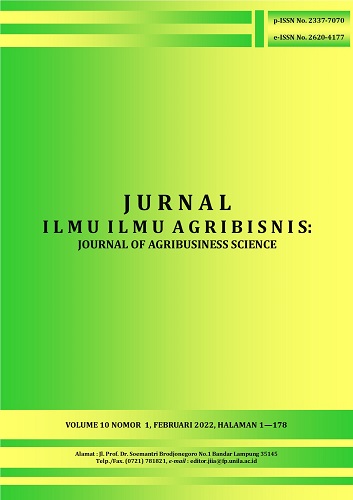SIKAP DAN PERMINTAAN KONSUMEN RUMAH TANGGA TERHADAP DAGING AYAM RAS SEGAR DAN DAGING AYAM RAS BEKU DI KOTA BANDAR LAMPUNG
DOI:
https://doi.org/10.23960/jiia.v10i1.5685 Abstract View: 416
Abstract View: 416
Abstract
Along with the development of science and technology, broilers are not only sold in fresh but also in frozen condition. This study aims to determine consumers’ attitudes and the factors that influence their demand of fresh broilers and frozen broilers in Bandar Lampung City. This research was conducted at three markets namely Pasir Gintung, Koga, Way Kandis, and in three supermarkets namely Chandra Tanjung Karang, Chandra Teluk Betung, and Transmart. The number of consumer respondents was 60 people, recruited accidentally. Research data were analyzed using multiatribute Fishbein and Seemingly Unrelated Regression. Consumers’ attitude showed that the color and the scent of fresh broilers and frozen broilers got the highest scores. The demand of fresh broilers was influenced by the price of fish, the price of cooking oil, the price of tempeh, and the number of household members. The demand of frozen broilers was influenced by the price of fresh broilers, the price of frozen broilers, the price of cooking oil, the price of tempeh, household total income, and the number of household members.
Key words: attitudes, consumer, demand, fresh broilers, frozen broilers
Downloads
Downloads
Published
How to Cite
Issue
Section
License
Authors who publish with this journal agree to the following terms:
Authors retain copyright and grant the journal right of first publication with the work simultaneously licensed under a Creative Commons Attribution License that allows others to share the work with an acknowledgement of the work's authorship and initial publication in this journal.
Authors are able to enter into separate, additional contractual arrangements for the non-exclusive distribution of the journal's published version of the work (e.g., post it to an institutional repository or publish it in a book), with an acknowledgement of its initial publication in this journal.
Authors are permitted and encouraged to post their work online (e.g., in institutional repositories or on their website) prior to and during the submission process, as it can lead to productive exchanges, as well as earlier and greater citation of published work (See The Effect of Open Access).














